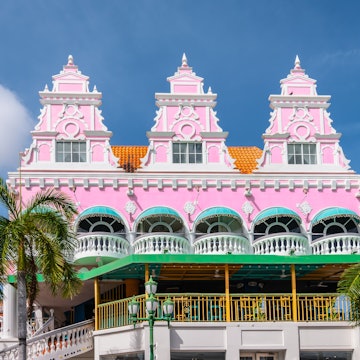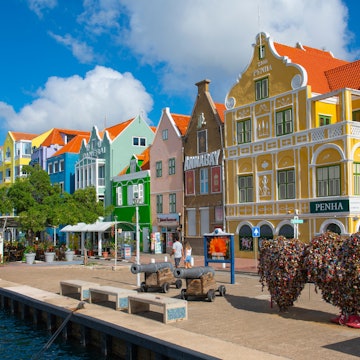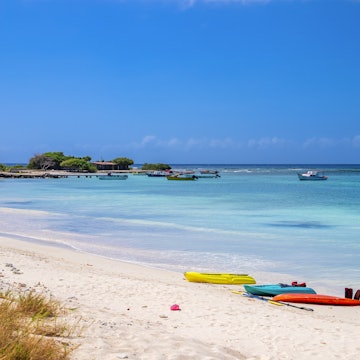
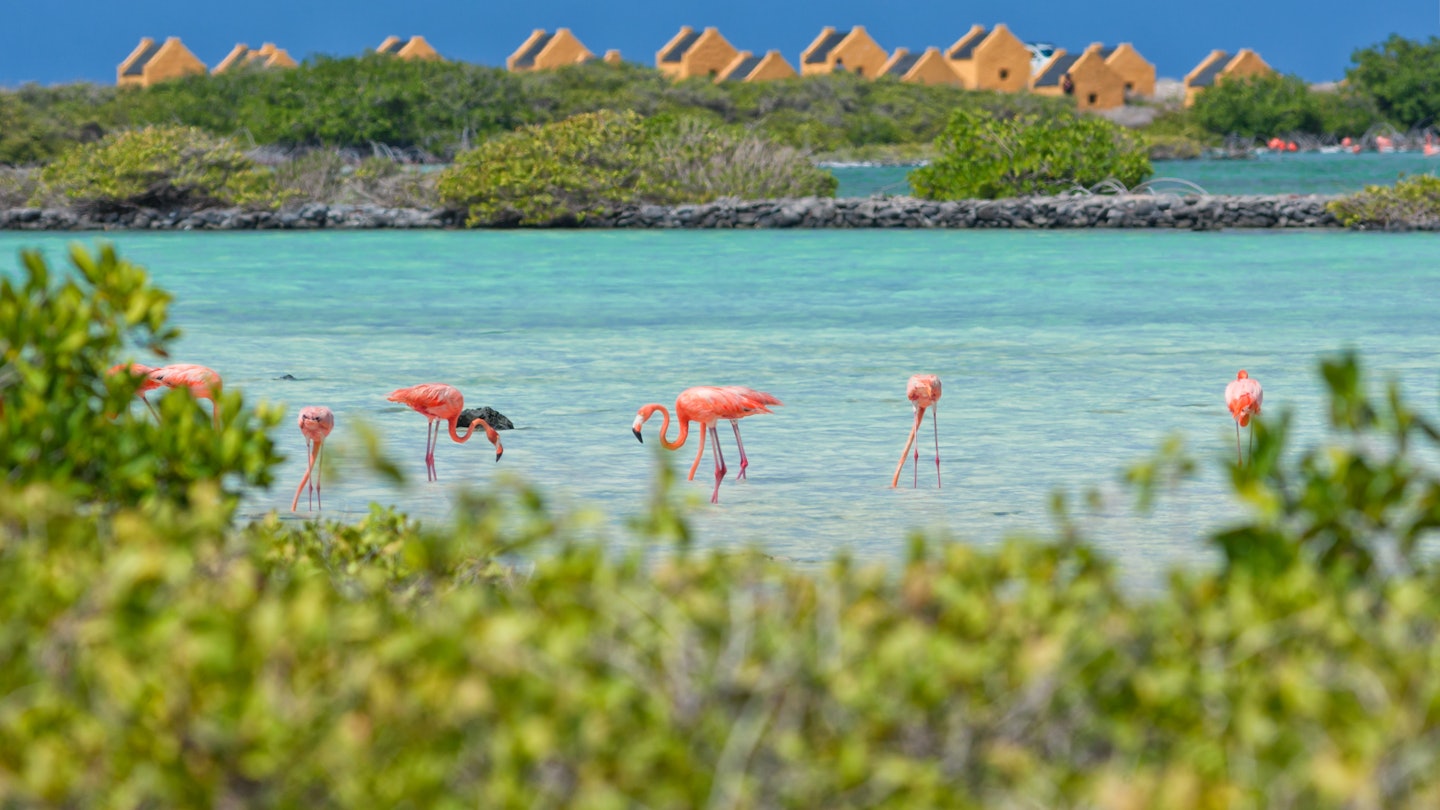
Despite vibrant reefs, an abundance of flamingos, and excellent food, Bonaire is still off-the-radar for many travelers. StephanKogelman/Shutterstock
When you go swimming, snorkeling or diving in Bonaire, you have the privilege of doing so in the only country that is surrounded by a protected marine park in its entirety. By visiting the Dutch Caribbean island, you would also be getting a passport stamp from the world’s first blue destination.
Located comfortably outside the hurricane belt off the coast of Venezuela, Bonaire is often overshadowed by its glitzier neighbors Aruba and Curaçao, and many would struggle to pinpoint it on a map. Even people working in travel and aviation give blank stares when confronted with its name. Nevertheless, it’s the perfect hiding place for anyone who wishes to spot flamingos on the daily, admire pink lakes, wade through waters as blue as a KLM flight attendant’s uniform, sidestep excess crowds, and be spoiled by exquisite world-class cuisine in a splendidly multicultural setting.
When should I go to Bonaire?
No matter the month, you can always roll out of bed and step right into the ocean in Bonaire. With endless sunshine all year round, and no hurricanes, there really isn’t a “bad” time to visit. Downpours probably won’t thwart your outdoor plans either as the island only receives around 20 to 25 inches of rain every year.
Bonaire’s peak season is between December and March when snowbirds flock to escape the colder climates back home so if you're looking for the sweet spot between great weather and lower flight and accommodation rates, aim for April to October.
To experience Bonaire’s rich culture, it’s worth timing your trip to coincide with events like June’s San Pedro and San Juan festivals, non-stop, 24-hour annual music-filled celebrations that specifically honor people called Juan and Pedro, and any derivatives of those names.
Barí festival in the fall is when musicians chant and traipse around the village of Rincon – the oldest settlement in the Dutch Caribbean – and playfully reveal secrets from the past year. Scores are settled and any inappropriate behavior, gossip, misdeed, or scandal is laced into the lyrics of songs that are puzzles to be carefully deciphered.
Excitement and folkloric music also echo through the island’s streets during Flag Day (Dia di Boneiru) in September, the Maskarada festival on New Year’s Day, Bonaire’s monthlong carnival (in January, February or March) and spring’s Simadan sorghum harvest festival.
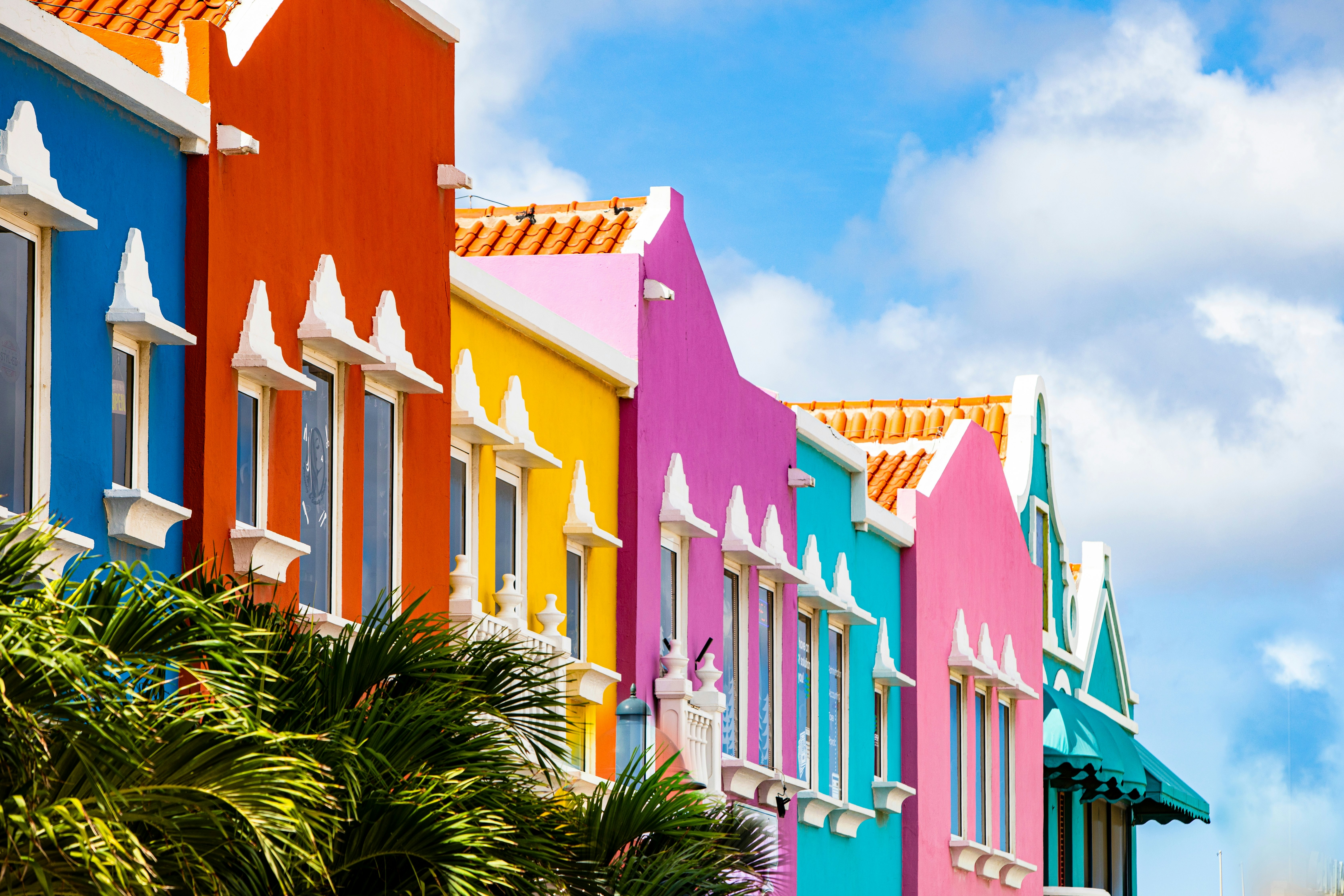
How much time should I spend in Bonaire?
A long weekend in Bonaire is enough to get your feet wet, literally. Two to three days will give you time to scan some of the best dive sites, snorkel its kaleidoscopic reefs, and get a taste of the island’s tranquil atmosphere. But if you’ve got four or five days to spare, you can dig deeper, go caving and mangrove snorkeling, and check out some untrammeled-yet-covetable beaches like Playa Chikitu and Boka Kokolishi at Washington Slagbaai National Park.
Note that flights from some U.S. cities only run on Saturdays so a seven-day stay might make the most sense.
Is it easy to get in and around Bonaire?
Most travelers arrive via Flamingo International Airport (BON) which is petite and pink. American Airlines, Delta, JetBlue, and United fly to Bonaire from Miami, Atlanta, New York (JFK), Newark, and Houston, while Westjet brings in Canadian travelers from Toronto. For European visitors, there are daily flights from Amsterdam.
Getting from the airport to Kralendijk, the island’s capital, is a breeze. It’s just a quick 10-minute drive, and taxis are readily available.
Public transport is virtually nonexistent in Bonaire so renting a car is essential. Liberate yourself to circumnavigate the entire 24-mile-long island – which can easily be done in a single day – by hiring a four-wheel drive with trunk space for all your gear if you’re planning to dive.
If you’re staying in Kralendijk, you can easily explore on foot. Its colorful streets, waterfront restaurants, and dive shops are all within walking distance.
Top things to do in Bonaire

Dive into Bonaire’s Marine Park
As inscribed on all car number plates, Bonaire is a bonafide “diver’s paradise.” For three decades, Scuba Diving Magazine’s readers have voted it the Best Shore Diving Destination in the Caribbean. Bonaire has 86 dive sites marked with bright yellow rocks, 54 of which are accessible right from shore. And once you’re in the crystal-clear water, it’s another world with over 350 species of fish.
For a real treat, head to the Hilma Hooker shipwreck or world-renowned diving location 1000 Steps Beach, which gets its name from the trepidation one feels about climbing the stairs with heavy dive gear in tow. In reality, there are only 79 steps.
Sip cactus vodka at a former picture house
In a former cinema in the village of Rincon, the Cadushy Distillery is run by Dutchman Eric Gietman and his wife Jolande. It creates small batches of what’s deemed to be the world’s first cactus vodka and it is described as being “smooth with a spiny character.” Gietman started his cactus creations after he realized that Bonaire lacked a distinctive and lovable export that could act as a souvenir for the water lovers who continuously flocked to the island for diving. With no shortage of cactuses on the island (there are more of these than people), they were the perfect ingredient for his concoctions. Everything is made on-site at the distillery which opened in 2010, and interestingly, the cactuses are dried in car windshields.
Cadushy is Bonaire's only distillery and it produces six liqueurs in honor of all the region's islands (besides Sint Maarten). These are Cadushy of Bonaire, Kukui of Aruba, Calbas of Curaçao, Gold of Statia, Spices of Saba, and Royal Orange of Orange for the Kingdom of The Netherlands which the Dutch royals gave their stamp of approval to during their 2011 tour. Entry is free.

Windsurf with world champions
Steady trade winds and shallow, impossibly clear waters make Lac Bay a haven for both seasoned pros and beginner windsurfers looking to catch their first wave. And if you’re lucky, you might just find yourself learning the ropes from none other than Taty and Tonky Frans – world champion windsurfers who’ve returned home to teach at their very own school, The Frans Paradise. After breaking records across the globe in over 25 countries, from Canada to Turkmenistan, the brothers are back in Bonaire where it all started.
Go landsailing on a blokart
What is a blokart, you ask? It’s a three-wheeled land yacht or sail-powered go-kart, and a whole lot of fun. Go to Bonaire Landsailing and after a straightforward training session, you’ll be blasting through the landsailing track, Bonairian wind in your hair, in no time. The friendly folks there will even throw in photos of your experience at no extra cost.
Make time for Washington Slagbaai National Park
Washington Slagbaai National Park is a rugged, windswept playground that covers nearly 20 percent of Bonaire. This is where the island's adventurous come to hike up the jagged trails of Brandaris (the highest point on the island) and get some cliff-jumping thrills. The park’s hiking trails and two driving routes take you past all of this and more – snorkeling spots, mysterious caves, and miles of untamed coastline that feel like something straight out of a daydream, if you’re the type who fantasizes about getting away from it all.
My favorite things to do in Bonaire
Flamingos are always the star of the show for me in Bonaire. On top of seeing them, you can practically drink, sleep, play, or shop for anything flamingo-related on the island. From the moment you touch down at Flamingo Airport, you’re already knee-deep in this pink-feathered world. You can sleep at Divi Flamingo Beach Resort, maybe catch a local SV Atlétiko Flamingo football match, and shop at Kralendijk’s boutiques for the flamingo-related tchotchkes you never knew you needed.
Certain protected parts of the island are solely dedicated to these wading birds as if they own the place. Spending a quiet afternoon at Gotomeer is an experience I always cherish as I get to watch dozens of these iconic pink birds, necks outstretched, moving gracefully across the shallow waters.
When in Bonaire, I also love dining alfresco, people watching, and courteously eavesdropping on conversations that seem to be conducted in every language under the sun. People flit between English, Spanish, Dutch, and Papiamentu (a local Creole that pulls bits from Portuguese, Spanish, Dutch, and English). Sit down at any restaurant and don’t be shocked if your server glides between languages mid-sentence.
On the restaurant front, despite its size, Bonaire really punches above its weight with a culinary scene ranging from kitschy joints serving lionfish burgers to chef’s table experiences that sell out a year in advance. I never decline an invitation to Sebastian’s, Ocean Oasis, La Balandra, or waterfront institution Karel’s.

How much money do I need for Bonaire?
The U.S. dollar has been Bonaire’s currency since 2011. Compared to other Caribbean islands, Bonaire is not prohibitively exorbitant but your wallet won’t go unscathed. Many items are imported which impacts prices. Some businesses don’t have card readers so it’s wise to carry a bit of cash with you at all times.
Basic hotel room for two: US$70–US$130
Airbnb or self-catering apartment: US$90–US$200 per night
Cocktail: US$9
Local beer at the bar: US$3–US$5
Ice cream scoop: US$4
Lunch: US$15–US$30
Dinner for two: US$50–US$120
Car rental (per day): US$29–US$79
Guide diving (per dive): US$55–US$70 (plus gear rental if needed)







